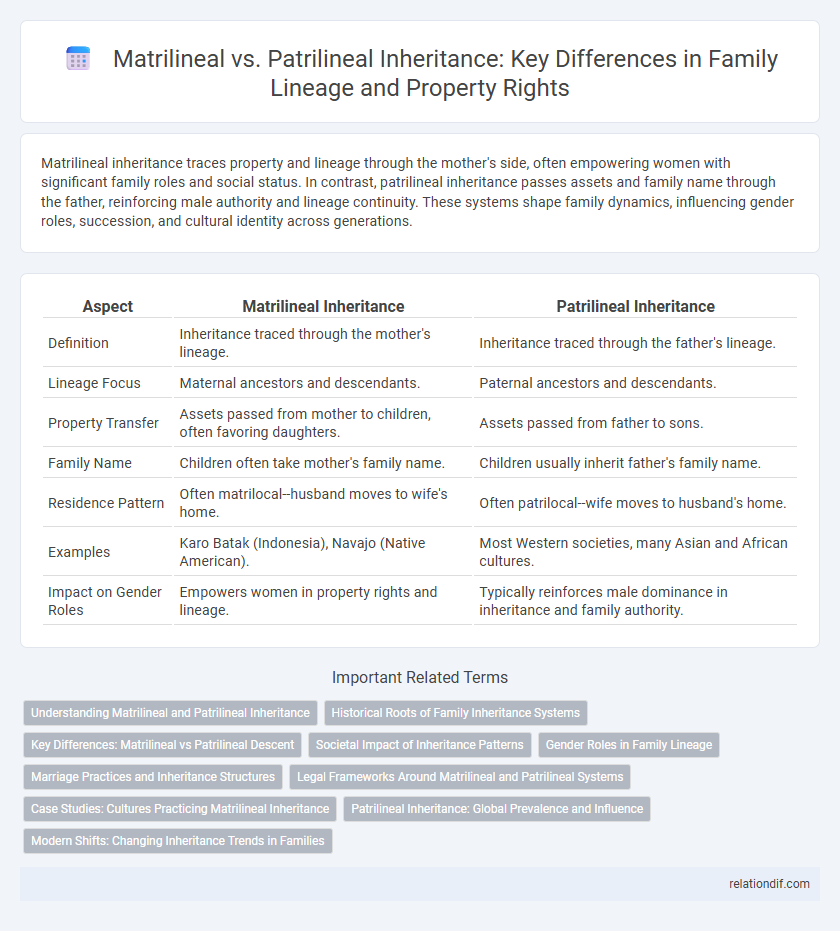Matrilineal inheritance traces property and lineage through the mother's side, often empowering women with significant family roles and social status. In contrast, patrilineal inheritance passes assets and family name through the father, reinforcing male authority and lineage continuity. These systems shape family dynamics, influencing gender roles, succession, and cultural identity across generations.
Table of Comparison
| Aspect | Matrilineal Inheritance | Patrilineal Inheritance |
|---|---|---|
| Definition | Inheritance traced through the mother's lineage. | Inheritance traced through the father's lineage. |
| Lineage Focus | Maternal ancestors and descendants. | Paternal ancestors and descendants. |
| Property Transfer | Assets passed from mother to children, often favoring daughters. | Assets passed from father to sons. |
| Family Name | Children often take mother's family name. | Children usually inherit father's family name. |
| Residence Pattern | Often matrilocal--husband moves to wife's home. | Often patrilocal--wife moves to husband's home. |
| Examples | Karo Batak (Indonesia), Navajo (Native American). | Most Western societies, many Asian and African cultures. |
| Impact on Gender Roles | Empowers women in property rights and lineage. | Typically reinforces male dominance in inheritance and family authority. |
Understanding Matrilineal and Patrilineal Inheritance
Matrilineal inheritance traces lineage and property through the mother's line, influencing family structure and cultural identity in societies such as the Minangkabau of Indonesia. Patrilineal inheritance passes assets and family name through the father's lineage, commonly found in patriarchal societies like many in the Middle East and South Asia. Understanding these systems reveals how inheritance practices shape social roles, kinship bonds, and power dynamics within families.
Historical Roots of Family Inheritance Systems
Matrilineal inheritance systems trace property and lineage through the mother's side, predominantly found in societies such as the Minangkabau of Indonesia and the Cherokee Nation, reflecting historical social structures that emphasize female lineage and clan identity. Patrilineal inheritance systems, common in ancient societies like Mesopotamia and most traditional European cultures, pass property and family name through the father's lineage, reinforcing patriarchal norms and male dominance in familial authority. These contrasting inheritance systems reveal deep-rooted cultural values and social organization patterns that have historically shaped family roles and intergenerational wealth transmission.
Key Differences: Matrilineal vs Patrilineal Descent
Matrilineal inheritance traces family lineage and property rights through the mother's line, emphasizing maternal ancestors and often granting women central roles in heritage transmission. Patrilineal inheritance follows the father's line, passing down names, titles, and assets primarily through male descendants, reinforcing paternal authority within the family structure. These contrasting systems shape social organization, influence kinship bonds, and determine succession in various cultures worldwide.
Societal Impact of Inheritance Patterns
Matrilineal inheritance often empowers women by preserving property and social status through the female line, enhancing their influence within the family and community. In contrast, patrilineal inheritance typically consolidates wealth and authority among male descendants, reinforcing patriarchal structures and limiting women's economic independence. These differing patterns shape societal norms, affecting gender roles, family dynamics, and the distribution of power across generations.
Gender Roles in Family Lineage
Matrilineal inheritance emphasizes the transmission of family name, property, and social status through female lineage, often granting women pivotal roles in family decision-making and cultural continuity. Patrilineal inheritance, conversely, centers on male lineage, reinforcing patriarchal authority and typically prioritizing sons in succession and family leadership. These contrasting systems shape gender roles by either empowering women as lineage bearers and heritage custodians or reinforcing traditional male dominance within familial hierarchies.
Marriage Practices and Inheritance Structures
Matrilineal inheritance structures emphasize property and lineage passing through the female line, influencing marriage practices where husbands often join the wife's family household. Patrilineal systems prioritize descent and inheritance through the male line, typically resulting in brides moving to the husband's home and property being inherited by sons. These contrasting frameworks shape family roles, residence patterns, and the transmission of wealth across generations.
Legal Frameworks Around Matrilineal and Patrilineal Systems
Legal frameworks surrounding matrilineal and patrilineal inheritance systems vary significantly across jurisdictions, reflecting cultural, social, and historical influences. In countries with matrilineal systems, laws often ensure property and lineage pass through the female line, providing women with rights to inherit land, titles, or assets, while patrilineal frameworks prioritize male descendants in succession and inheritance rights. Contemporary legal reforms increasingly address gender equity by modifying traditional rules to balance inheritance rights between matrilineal and patrilineal practices.
Case Studies: Cultures Practicing Matrilineal Inheritance
Cultures such as the Mosuo in China, the Khasi in India, and the Minangkabau in Indonesia exemplify matrilineal inheritance systems where property and family lineage pass through the female line. In these societies, women often hold significant authority over household assets, land, and social roles, contrasting with patrilineal traditions that prioritize male heirs. This distinct inheritance pattern shapes family dynamics, gender relations, and social organization within these communities.
Patrilineal Inheritance: Global Prevalence and Influence
Patrilineal inheritance, where property and family name pass through the male lineage, is predominant in many societies worldwide, especially in Asia, Africa, and parts of the Middle East. This system influences societal structures by reinforcing male authority and impacting land ownership, wealth distribution, and lineage recognition. Studies show that patrilineal inheritance correlates with patriarchal norms and affects gender roles, access to resources, and legal frameworks governing family rights globally.
Modern Shifts: Changing Inheritance Trends in Families
Modern shifts in inheritance patterns show a gradual move from traditional patrilineal systems, where property passes through the male line, towards matrilineal and more egalitarian models that recognize women's rights to inherit. Urbanization, legal reforms, and increasing female economic participation contribute to these changes, reflecting evolving family dynamics. Data from diverse cultures highlight how inheritance laws increasingly incorporate gender equality, reshaping familial wealth distribution.
matrilineal inheritance vs patrilineal inheritance Infographic

 relationdif.com
relationdif.com